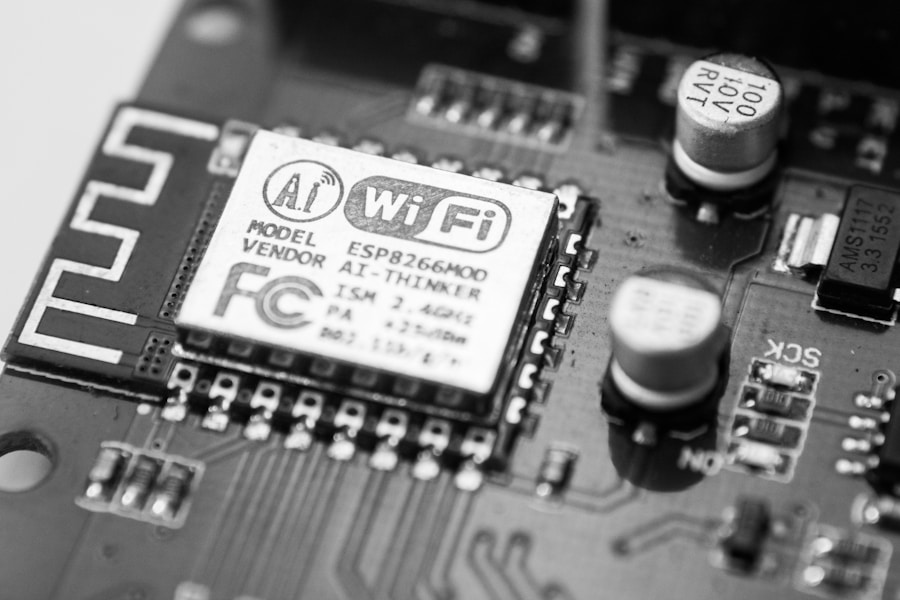In an era where the Internet of Things (IoT) is rapidly transforming our daily lives, the security of Wi-Fi networks has become paramount. IoT devices, ranging from smart thermostats and security cameras to connected kitchen appliances, are increasingly integrated into our homes and workplaces. These devices often collect and transmit sensitive data, making them attractive targets for cybercriminals.
A compromised IoT device can lead to unauthorized access to personal information, financial data, and even control over physical systems within a home or business. Therefore, understanding the importance of secure Wi-Fi networks is crucial for safeguarding these devices and the data they handle. The vulnerabilities associated with IoT devices are exacerbated by the fact that many users do not prioritize network security.
Default settings, weak passwords, and outdated firmware can leave devices exposed to attacks. For instance, a poorly secured smart camera could be hacked, allowing intruders to spy on the household or even gain access to the home network. Moreover, as more devices connect to the internet, the potential attack surface increases, making it essential to implement robust security measures.
By ensuring that Wi-Fi networks are secure, users can significantly reduce the risk of unauthorized access and protect their privacy.
Key Takeaways
- Secure Wi-Fi networks are crucial for protecting IoT devices from unauthorized access and potential security breaches.
- Choosing a strong and unique Wi-Fi network name and password is the first line of defense against potential hackers.
- Enabling WPA2 or WPA3 encryption for Wi-Fi security adds an extra layer of protection for IoT devices.
- Setting up a guest network for IoT devices can help isolate them from the main network and prevent unauthorized access to sensitive data.
- Regularly updating firmware and software for IoT devices is essential for addressing security vulnerabilities and keeping devices protected from potential threats.
Choosing a Strong and Unique Wi-Fi Network Name and Password
Choosing a Secure Network Name (SSID)
Selecting a strong and unique network name (SSID) is a crucial step in protecting your Wi-Fi network.
For instance, using a name like “SmithFamilyWiFi” can provide potential attackers with insights into the household structure, making it easier for them to target specific vulnerabilities.
Creating a Strong Password
When it comes to passwords, complexity is key. A strong password should be at least 12-16 characters long and include a mix of uppercase and lowercase letters, numbers, and special characters. Avoid using common phrases or easily guessable information, such as birthdays or pet names. Instead, opt for a more secure option like “G7!kL9@qW3#zP1.”
Avoiding Default Passwords
Changing the default password provided by the manufacturer is critical. Many users neglect this step, leaving their networks vulnerable to attacks that exploit default credentials. By following these guidelines, you can significantly reduce the risk of your Wi-Fi network being compromised.
Enabling WPA2 or WPA3 Encryption for Wi-Fi Security
To enhance Wi-Fi security further, enabling WPA2 (Wi-Fi Protected Access 2) or WPA3 encryption is vital.
This protocol ensures that data transmitted over the network is encrypted, making it significantly more difficult for unauthorized users to intercept and decipher sensitive information.
However, with advancements in technology and increasing cyber threats, WPA3 has emerged as the next generation of Wi-Fi security. WPA3 offers several improvements over its predecessor, including enhanced protection against brute-force attacks and improved encryption methods. One notable feature is its use of Simultaneous Authentication of Equals (SAE), which provides stronger password-based authentication.
This means that even if an attacker attempts to guess a password through repeated attempts, WPA3 makes it increasingly difficult for them to succeed. By enabling either WPA2 or WPA3 encryption on Wi-Fi networks, users can create a formidable barrier against potential intrusions and ensure that their IoT devices operate within a secure environment.
Setting Up a Guest Network for IoT Devices
Creating a guest network specifically for IoT devices is an effective strategy for enhancing overall network security. A guest network operates separately from the primary home or business network, allowing IoT devices to connect without exposing sensitive data or systems to potential threats. This segmentation minimizes the risk of unauthorized access to critical devices such as computers or personal smartphones.
When setting up a guest network, it is essential to configure it with its own unique SSID and password. This ensures that guests cannot inadvertently access the main network while still allowing them to connect to the internet. Additionally, limiting the bandwidth available on the guest network can prevent any single device from consuming excessive resources, which could impact performance.
By isolating IoT devices on a guest network, users can significantly reduce their exposure to cyber threats while maintaining convenient access for necessary devices.
Updating Firmware and Software for IoT Devices Regularly
Regularly updating firmware and software for IoT devices is crucial in maintaining their security posture. Manufacturers frequently release updates that address vulnerabilities discovered after a device’s initial release. Failing to apply these updates can leave devices susceptible to known exploits that attackers can leverage to gain unauthorized access.
For example, in 2020, researchers discovered vulnerabilities in certain smart home devices that could allow hackers to take control of them remotely if they were not updated. To ensure that IoT devices remain secure, users should establish a routine for checking for updates. Many modern devices offer automatic update features; however, it is essential to verify that these settings are enabled.
In cases where automatic updates are not available, users should regularly visit the manufacturer’s website or consult their device’s app for any available patches or updates. By staying proactive about firmware and software updates, users can significantly mitigate risks associated with outdated security measures.
Implementing Network Segmentation for IoT Devices
Network segmentation involves dividing a larger network into smaller, isolated segments to enhance security and performance. For IoT devices, this practice is particularly beneficial as it limits the potential impact of a security breach. By creating separate segments for different types of devices—such as smart home appliances, security cameras, and personal computers—users can contain any potential threats within a specific segment without allowing them to spread across the entire network.
Implementing network segmentation can be achieved through various methods, including virtual local area networks (VLANs) or using separate physical routers for different segments. For instance, a user might set up one VLAN for all smart home devices while keeping personal computers on another VLAN. This way, even if an attacker gains access to one segment through a compromised IoT device, they would face additional barriers when attempting to infiltrate other segments containing more sensitive information or critical systems.
Using Firewall and Intrusion Detection Systems for Added Security
Incorporating firewalls and intrusion detection systems (IDS) into network security strategies provides an additional layer of protection for IoT devices. Firewalls act as gatekeepers between internal networks and external traffic, monitoring incoming and outgoing data packets based on predetermined security rules. By configuring firewalls to block unauthorized access attempts and suspicious traffic patterns, users can significantly reduce the risk of cyberattacks targeting their IoT devices.
Intrusion detection systems complement firewalls by actively monitoring network traffic for signs of malicious activity or policy violations. These systems analyze data packets in real-time and can alert users or administrators when suspicious behavior is detected. For example, if an IDS identifies unusual traffic patterns indicative of a potential attack—such as multiple failed login attempts from an unknown IP address—it can trigger alerts that prompt immediate investigation and response.
By utilizing both firewalls and IDS solutions, users can create a robust defense against cyber threats targeting their IoT ecosystems.
Monitoring Network Traffic and Device Activity for Suspicious Behavior
Continuous monitoring of network traffic and device activity is essential for identifying potential security breaches before they escalate into significant issues. By employing network monitoring tools, users can gain insights into how their IoT devices communicate with each other and with external servers. This visibility allows for the detection of anomalies that may indicate unauthorized access or malicious activity.
For instance, if an IoT device suddenly begins transmitting large amounts of data at unusual times or communicating with unfamiliar IP addresses, it could signal a compromise. Users should establish baseline behavior patterns for their devices so that deviations from these norms can be quickly identified. Additionally, many modern routers come equipped with built-in monitoring features that provide real-time insights into connected devices’ activity levels and data usage patterns.
By actively monitoring network traffic and device behavior, users can take swift action against potential threats before they result in significant damage or data loss.
If you are interested in setting up a secure home Wi-Fi network with IoT devices, you may also want to check out this article on Wired.com that focuses on how emerging technologies are shaping the future of smart homes. It provides valuable insights into the latest trends and innovations in the world of IoT devices and home automation.
FAQs
What is a Wi-Fi network?
A Wi-Fi network is a wireless network that allows devices to connect to the internet and communicate with each other using radio waves.
What are IoT devices?
IoT (Internet of Things) devices are everyday objects that are connected to the internet, allowing them to send and receive data. Examples include smart thermostats, security cameras, and smart speakers.
Why is it important to secure a home Wi-Fi network with IoT devices?
Securing a home Wi-Fi network with IoT devices is important to protect personal data, prevent unauthorized access to devices, and ensure the overall security of the network.
How can I set up a secure home Wi-Fi network with IoT devices?
To set up a secure home Wi-Fi network with IoT devices, you can start by changing the default passwords on your devices, enabling network encryption (such as WPA2), and regularly updating the firmware on your devices.
What are some additional security measures for a home Wi-Fi network with IoT devices?
Additional security measures for a home Wi-Fi network with IoT devices include using a firewall, setting up a guest network for visitors, and disabling remote access to devices when not in use.
What are the potential risks of not securing a home Wi-Fi network with IoT devices?
The potential risks of not securing a home Wi-Fi network with IoT devices include unauthorized access to personal data, hacking of IoT devices, and potential compromise of the entire network.



